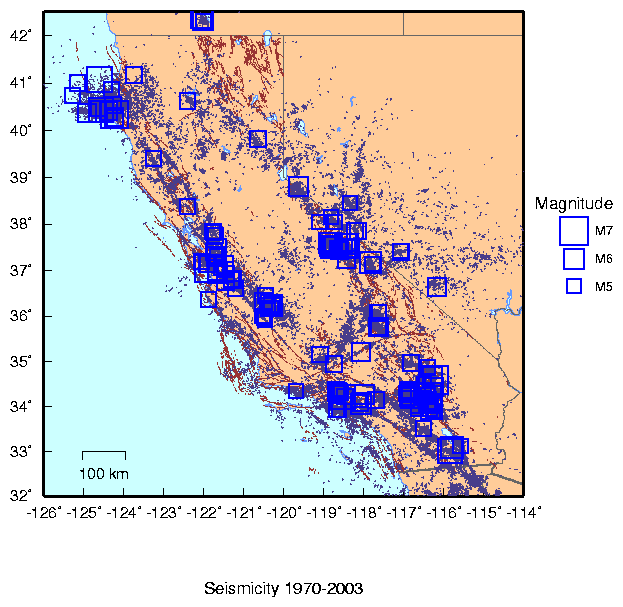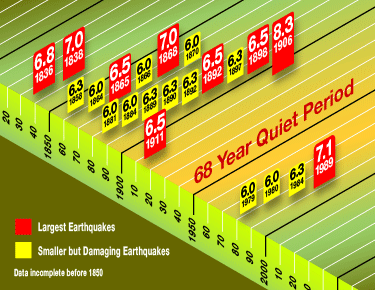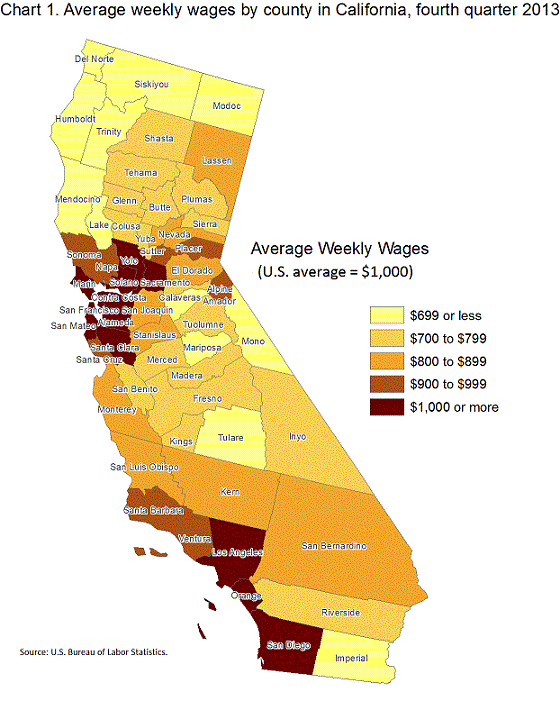For links see article source.....
Posted for fair use.....
http://www.ft.com/cms/s/0/fa829cac-cefc-11e4-b761-00144feab7de.html#axzz3YaK3iCsu
April 26, 2015 11:59 pm
California prepares for the next ‘big one’
Amy Bell
The 800-mile San Andreas Fault, which runs from northern California to Mexico, has been the source of the state’s biggest earthquakes. Known as the ‘sleeping giant’, it is one of more than 350 faults that are found across the state.
Scientists now predict that the risk of a mega quake in the next 30 years is higher than was previously thought.
The Third Uniform California Earthquake Rupture Forecast (UCERF3), published in March, includes newly discovered fault zones and accounts for the possibility of an earthquake jumping between them. This could result in multiple faults shaking in a simultaneous mega quake (magnitude-8), releasing enough energy to cause massive destruction.
The report says that, while there is a lower likelihood of moderate-sized earthquakes, the odds of a mega quake occurring in the next 30 years have increased from 4.7 per cent to 7 per cent.
Earthquakes are nothing new for Californians. The state experiences 1,000 quakes a year, but most are too small to be felt. While the San Andreas Fault has experienced massive earthquakes in the central and northern segments — Fort Tejon in 1857 and San Francisco in 1906 — the southern section has not had a large quake for more than 300 years.
Preparing for the next ‘big one’ is the formidable challenge facing state policy makers. In his 2015 inaugural address, California’s insurance commissioner Dave Jones said that earthquake protection was his top priority.
“If you ask me what keeps me awake at night, it’s the strong likelihood of a large earthquake,” he said.
Robert Hartwig, president of the Insurance Information Institute, says that California is now better prepared for a big earthquake from a structural standpoint than it was in 1994 when the last significant quake hit the state.
The Northridge quake caused 57 deaths and an estimated $20bn in damage. Improvements have resulted from stronger building codes for new constructions and infrastructure and retrofits of older buildings, he says.
Public schools and hospitals have stringent, enforced building codes, with design and construction managed by the state. All codes are updated regularly, based on scientific studies of past earthquakes, ensuring that the most effective design and construction procedures apply. These include using improved materials and employing structural measures such as base isolaters where buildings rest on flexible bearings and only move a little during an earthquake.

http://im.ft-static.com/content/images/00743292-ea37-11e4-ae1c-00144feab7de.img
However, many buildings in California, particularly concrete or soft storey wooden structures (where one floor is open space, causing a weak point), were built before the development of modern seismic maps and are not considered earthquake-safe. Current building codes apply exclusively to new constructions; existing buildings need only adhere to the codes in place at the time of construction.
Seismic retrofitting can improve the resilience of older structures by strengthening structural elements, but in most cases it remains voluntary.
Eric Garcetti, mayor of Los Angeles, recently implemented a seismic safety campaign to improve the city’s resilience, following a report led by Lucy Jones, a US Geological Survey seismologist. The report proposes fortifying buildings, the water system and telecommunications networks at an estimated cost of more than $1bn and appears to be progressing. Previous calls for mandatory seismic upgrades met with protests from building owners and there is still concern about how the cost of retrofits will be covered.
Better public understanding of the earthquake threat has been a crucial part of the process. Dr Jones liaised with community groups and city departments over a year-long period, warning of the risk of doing nothing.
The estimated cost of damage to Los Angeles in its current state, if a big earthquake were to hit, would be more than $210bn.
The risk to Los Angeles, with a population of approximately 18.5m, is particularly high because of the many faults, but other densely populated zones are also at risk, including the San Francisco Bay area, which is working on a plan to strengthen the area’s resilience.
The findings of the UCERF3 report have been included in the 2014 update of the earthquake hazard maps. Such maps are essential in earthquake preparation, as they are used by engineers, planners and building code officials.
The risks are reflected in the insurance rates for earthquake coverage. Chris Schultz, deputy insurance commissioner, estimates that in high-risk areas insurance may cost $3,000 a year or more. In some cases he says, retrofitting at a one-off cost of $3,000-$10,000 could be a better choice.
Many insurers were caught off-guard by the 1994 quake and began to restrict coverage and increase rates as a result. Unlike flood insurance, earthquake cover is not provided by the state and must be purchased from private companies. Separate earthquake insurance must be offered under Californian law to policyholders, but it is not mandatory and many choose not to purchase it because of the cost.
Mr Schultz says a mere 11 per cent of homeowners and tenants in California currently have earthquake insurance, and commercial uptake is similarly low. The California Department of Insurance is trying to secure funding for grants to encourage people to retrofit their properties he adds.
Mr Hartwig believes the reason so few Californians have earthquake insurance is complacency. “It has been 21 years since the last major earthquake in the state and many rationalise that they can do without.
Unfortunately, too many seem willing to play Russian roulette with what is likely to be their most valuable asset, their home.”
Christina Curry, assistant director at the governor’s Office of Emergency Services, believes that better public awareness and support are crucial. She cites the importance of current work on earthquake early warning detection and continued focus on the state’s Shakeout Scenario to ensure citizens know what to do in an earthquake.
However, for now, the onus is on individuals to insure their properties against earthquakes. The latest UCERF3 report may well serve as a reminder to property owners of the risks they face.
Posted for fair use.....
http://www.ft.com/cms/s/0/fa829cac-cefc-11e4-b761-00144feab7de.html#axzz3YaK3iCsu
April 26, 2015 11:59 pm
California prepares for the next ‘big one’
Amy Bell
The 800-mile San Andreas Fault, which runs from northern California to Mexico, has been the source of the state’s biggest earthquakes. Known as the ‘sleeping giant’, it is one of more than 350 faults that are found across the state.
Scientists now predict that the risk of a mega quake in the next 30 years is higher than was previously thought.
The Third Uniform California Earthquake Rupture Forecast (UCERF3), published in March, includes newly discovered fault zones and accounts for the possibility of an earthquake jumping between them. This could result in multiple faults shaking in a simultaneous mega quake (magnitude-8), releasing enough energy to cause massive destruction.
The report says that, while there is a lower likelihood of moderate-sized earthquakes, the odds of a mega quake occurring in the next 30 years have increased from 4.7 per cent to 7 per cent.
Earthquakes are nothing new for Californians. The state experiences 1,000 quakes a year, but most are too small to be felt. While the San Andreas Fault has experienced massive earthquakes in the central and northern segments — Fort Tejon in 1857 and San Francisco in 1906 — the southern section has not had a large quake for more than 300 years.
Preparing for the next ‘big one’ is the formidable challenge facing state policy makers. In his 2015 inaugural address, California’s insurance commissioner Dave Jones said that earthquake protection was his top priority.
“If you ask me what keeps me awake at night, it’s the strong likelihood of a large earthquake,” he said.
Robert Hartwig, president of the Insurance Information Institute, says that California is now better prepared for a big earthquake from a structural standpoint than it was in 1994 when the last significant quake hit the state.
The Northridge quake caused 57 deaths and an estimated $20bn in damage. Improvements have resulted from stronger building codes for new constructions and infrastructure and retrofits of older buildings, he says.
Public schools and hospitals have stringent, enforced building codes, with design and construction managed by the state. All codes are updated regularly, based on scientific studies of past earthquakes, ensuring that the most effective design and construction procedures apply. These include using improved materials and employing structural measures such as base isolaters where buildings rest on flexible bearings and only move a little during an earthquake.

http://im.ft-static.com/content/images/00743292-ea37-11e4-ae1c-00144feab7de.img
However, many buildings in California, particularly concrete or soft storey wooden structures (where one floor is open space, causing a weak point), were built before the development of modern seismic maps and are not considered earthquake-safe. Current building codes apply exclusively to new constructions; existing buildings need only adhere to the codes in place at the time of construction.
Seismic retrofitting can improve the resilience of older structures by strengthening structural elements, but in most cases it remains voluntary.
Eric Garcetti, mayor of Los Angeles, recently implemented a seismic safety campaign to improve the city’s resilience, following a report led by Lucy Jones, a US Geological Survey seismologist. The report proposes fortifying buildings, the water system and telecommunications networks at an estimated cost of more than $1bn and appears to be progressing. Previous calls for mandatory seismic upgrades met with protests from building owners and there is still concern about how the cost of retrofits will be covered.
Better public understanding of the earthquake threat has been a crucial part of the process. Dr Jones liaised with community groups and city departments over a year-long period, warning of the risk of doing nothing.
The estimated cost of damage to Los Angeles in its current state, if a big earthquake were to hit, would be more than $210bn.
The risk to Los Angeles, with a population of approximately 18.5m, is particularly high because of the many faults, but other densely populated zones are also at risk, including the San Francisco Bay area, which is working on a plan to strengthen the area’s resilience.
The findings of the UCERF3 report have been included in the 2014 update of the earthquake hazard maps. Such maps are essential in earthquake preparation, as they are used by engineers, planners and building code officials.
The risks are reflected in the insurance rates for earthquake coverage. Chris Schultz, deputy insurance commissioner, estimates that in high-risk areas insurance may cost $3,000 a year or more. In some cases he says, retrofitting at a one-off cost of $3,000-$10,000 could be a better choice.
Many insurers were caught off-guard by the 1994 quake and began to restrict coverage and increase rates as a result. Unlike flood insurance, earthquake cover is not provided by the state and must be purchased from private companies. Separate earthquake insurance must be offered under Californian law to policyholders, but it is not mandatory and many choose not to purchase it because of the cost.
Mr Schultz says a mere 11 per cent of homeowners and tenants in California currently have earthquake insurance, and commercial uptake is similarly low. The California Department of Insurance is trying to secure funding for grants to encourage people to retrofit their properties he adds.
Mr Hartwig believes the reason so few Californians have earthquake insurance is complacency. “It has been 21 years since the last major earthquake in the state and many rationalise that they can do without.
Unfortunately, too many seem willing to play Russian roulette with what is likely to be their most valuable asset, their home.”
Christina Curry, assistant director at the governor’s Office of Emergency Services, believes that better public awareness and support are crucial. She cites the importance of current work on earthquake early warning detection and continued focus on the state’s Shakeout Scenario to ensure citizens know what to do in an earthquake.
However, for now, the onus is on individuals to insure their properties against earthquakes. The latest UCERF3 report may well serve as a reminder to property owners of the risks they face.













